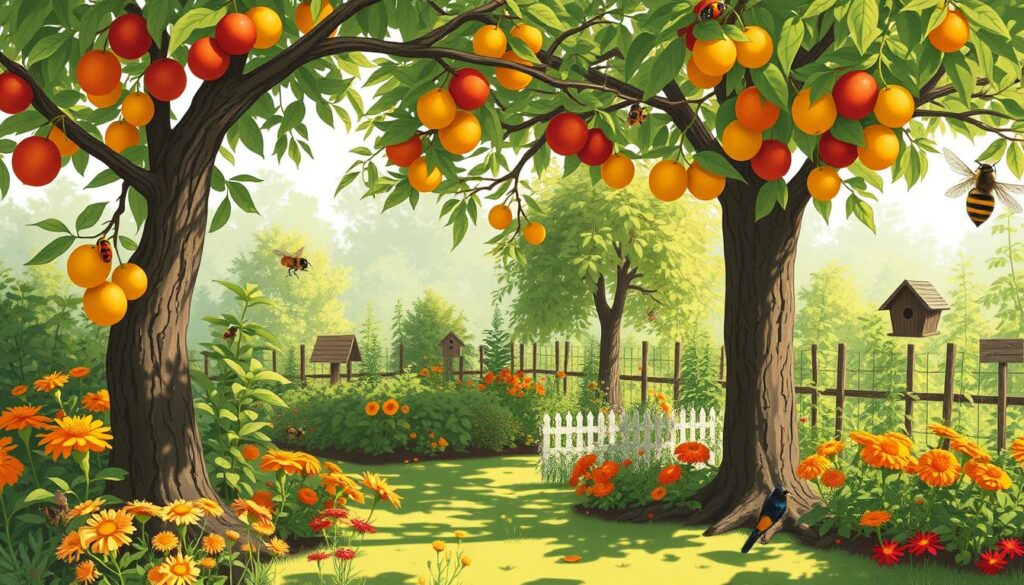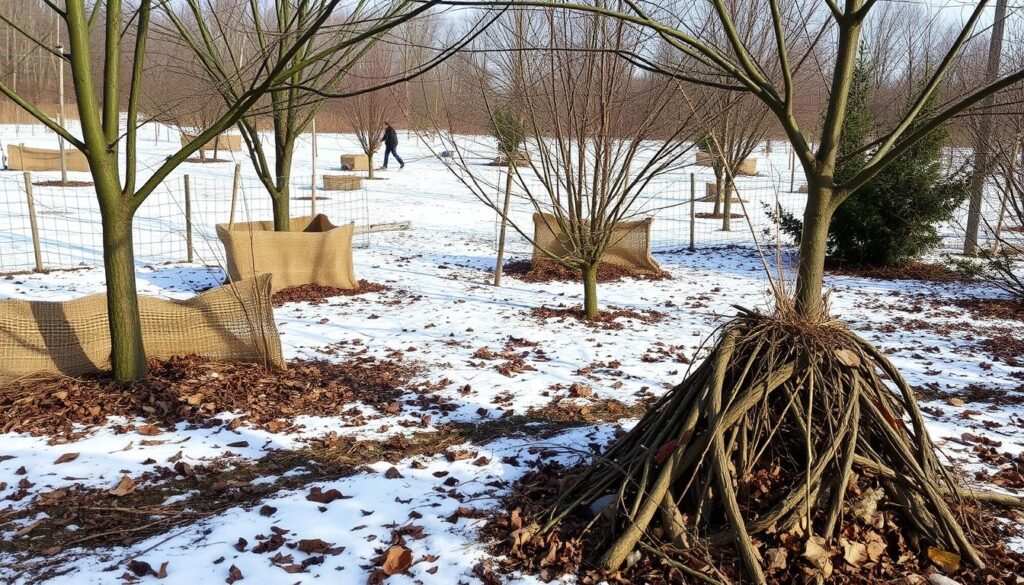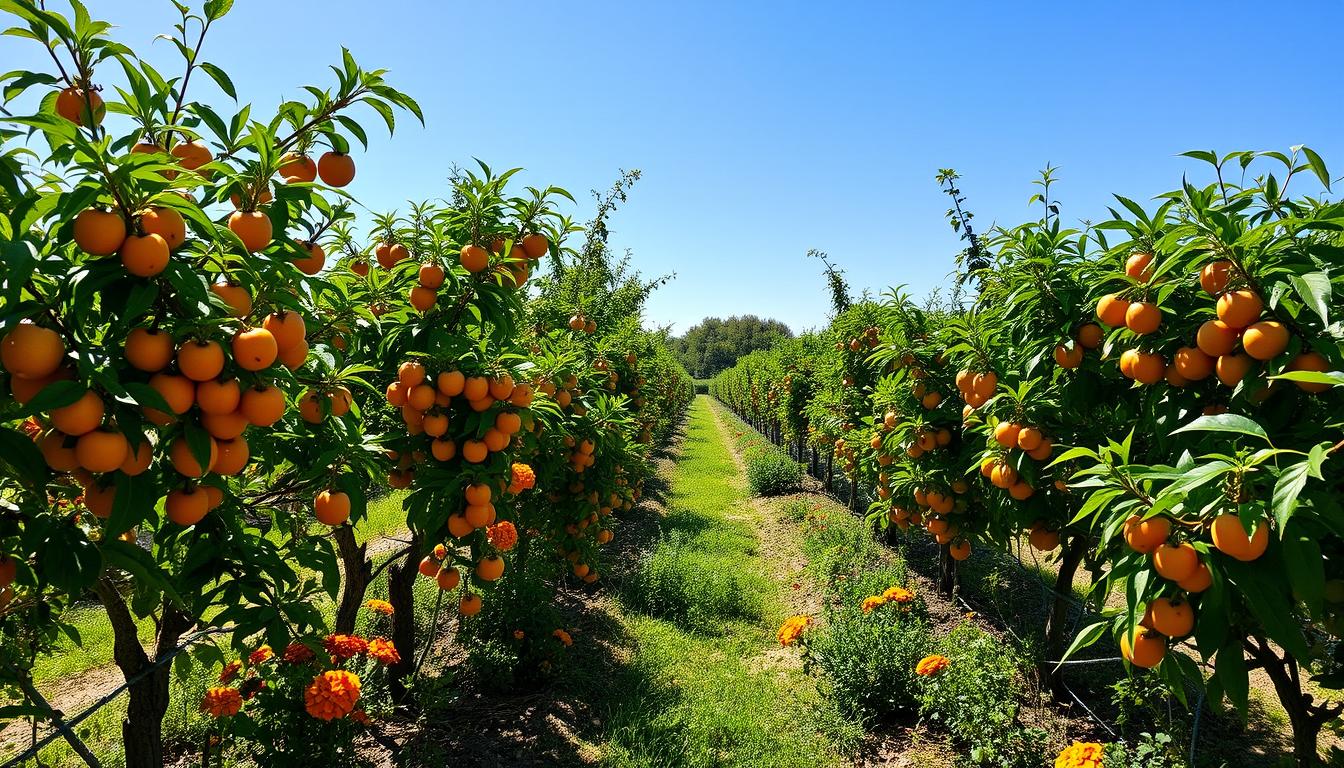I love gardening and always try to keep my fruit trees healthy. I also want to protect the environment. Using natural pest control for fruit trees is key to keeping our ecosystems balanced. It helps my orchard grow strong and supports wildlife too.
Key Takeaways
- Utilizing beneficial birds like Eastern bluebirds and tree swallows can naturally reduce pest populations.
- Beneficial insects such as ladybugs and lacewings can effectively control harmful bugs in orchards.
- Implementing orchard sox prevents significant damage from insects like apple maggots.
- A proactive cleaning strategy can deter overwintering pests and ensure a healthy next growing season.
- Maintaining tree health through monitoring and care makes fruit trees less attractive to pests.
Understanding the Importance of Pest Protection for Fruit Trees
Keeping fruit trees safe from pests is key to their health and success. Young trees need regular spraying to stay healthy and produce well. Pests and diseases can harm trees, reducing their yield and fruit tree health.
Each fruit tree faces unique challenges. For example, apples deal with scab, powdery mildew, and pests like the apple maggot. Pears face scab, trellis rust, and blister mite, while cherries battle bacterial canker and brown rot. Effective pest control is vital for protecting trees and ensuring a good harvest.
Many growers prefer organic pest control to avoid harsh chemicals. Organic products can fight off fungal and bacterial diseases, big problems in growing fruit trees. Regular care helps trees stay strong against pests.
When to spray is very important. Timing treatments with bud stages helps fight pests effectively. Using tools like USPest.org and Ag Weather Net can improve pest management for my area.
Common Pests that Affect Fruit Trees
Managing common fruit tree pests is key to keeping fruit trees healthy. Pests like the codling moth and aphids are major problems. The codling moth’s larvae damage apples and pears by burrowing into them. Aphids harm trees by sucking sap, causing leaves to curl and deform.
Diseases like brown rot and apple scab also harm trees. Knowing how to identify pests is important. It helps us take action early to protect our trees and fruit.
Here is a table summarizing common pests and their impacts on various fruit trees:
| Pest Name | Affected Fruit Trees | Impact |
|---|---|---|
| Codling Moth | Apples, Pears | Larvae burrow into fruit causing internal damage. |
| Aphids | Most Fruit Trees | Sap-sucking leads to curled leaves and reduced tree health. |
| Western Cherry Fruit Fly | Cherries | Infestations can result in maggot presence in fruit. |
| Greater Peachtree Borer | Peach, Nectarine, Apricot | Eggs laid at the tree base can cause tree stress or mortality. |
| Peach Twig Borer | Peach, Nectarine, Apricot | Tunnels into shoots, leading to twigs wilting and gum seepage. |
Knowing about these pests affecting orchards helps us manage our fruit trees better. By understanding the threats, we can take steps to protect our trees. This way, we can have a more successful harvest.
Benefits of Natural Pest Control
Using natural pest control has many benefits for fruit trees. It greatly reduces chemical runoff, which is good for the environment. Organic pest management also helps create a healthy ecosystem. This ecosystem includes beneficial insects that help pollinate and control pests.
Choosing eco-friendly pest solutions balances your orchard’s environment. By not using toxic pesticides, I protect native insects. These insects are key to a diverse ecosystem and healthy soil, which improves fruit quality.
Organic pest management also leads to sustainable productivity. Unlike chemical methods, it focuses on long-term success. It prevents problems like pest resistance and harm to non-target organisms.
Overall, natural pest management lets me enjoy my harvest while helping the environment. It teaches me about nature’s connections and my role as a land steward. By managing pests naturally, I appreciate the beauty of our ecosystem more.
How to Protect Your Fruit Trees from Pests Naturally
Home gardeners often ask how to protect their fruit trees naturally. Using natural methods can help manage pests in a sustainable way. This includes attracting beneficial birds, understanding pollinators, and using natural insect repellents.
Attracting Beneficial Birds
One great way is to attract beneficial birds for pest control. Birds like Eastern bluebirds eat harmful insects like caterpillars and aphids. By placing birdhouses near fruit trees, I encourage these birds to nest and help control pests.
This not only protects my trees but also boosts biodiversity in the area.
The Role of Pollinators
It’s important to know the role of pollinators in orchards for fruit production and tree health. To welcome these insects, I add a variety of flowering plants in my garden. This supports pollinators and helps keep harmful pests away.
By following these steps, I can grow a healthy orchard without relying on chemicals. For more tips and resources, check out Garden Beginner.
Utilizing Beneficial Insects for Pest Management
Using beneficial insects in pest control is very effective. It cuts down on the need for harmful chemicals. It also helps keep the ecosystem in balance in the orchard. Knowing which beneficial insects to use is key to managing pests naturally.
Types of Beneficial Insects to Introduce
Having a variety of beneficial insects can greatly reduce pest problems. Here are some of the most useful ones:
- Ladybugs: These bugs eat aphids and other soft-bodied pests, controlling their numbers.
- Lacewings: Their young eat lots of pests like aphids, caterpillars, and thrips.
- Parasitic Wasps: These wasps lay eggs inside pests like caterpillars, controlling their growth.
- Predatory Mites: These tiny mites attack spider mites and do well in many garden settings.
To attract these beneficial insects, I use natural pest control methods. This includes planting different flowers and avoiding harmful pesticides. By doing this, my orchard grows better with fewer pests, leading to more fruit in a green way.
Creating an Eco-Friendly Pest Management Plan
Creating an eco-friendly pest management plan is key to keeping fruit trees healthy and sustainable. It involves using sustainable pest control strategies to keep plants strong. This approach helps reduce harm to the environment.
Integrated Pest Management (IPM) is a great strategy. It looks at the whole area, protecting trees, plants, and buildings. By using cultural, physical, and biological methods, I make my garden less appealing to pests. For example, removing debris and planting herbs that repel pests helps.
Homemade insecticides are a green alternative to chemical sprays. I mix oils, spices, and soap to keep pests away. Organic pesticides like neem and diatomaceous earth target pests safely.
Keeping my yard clean is also part of the plan. It’s important to know what pests I have before treating them. Resources like university extensions and Master Gardener volunteers help with this.
By following these steps, my garden becomes a healthier and greener place. For more help or questions, visit my Contact page. It’s a great place to get more advice and support.

Homemade Fruit Tree Pest Repellents
Creating homemade fruit tree pest repellents is rewarding. I use common kitchen ingredients to make DIY pest control solutions. These solutions keep pests away without harmful chemicals. This helps my trees stay healthy and supports a healthier ecosystem.
Simple Recipes for DIY Repellents
Here are some easy recipes for natural repellents:
- Vegetable Oil Spray: Mix vegetable oil, water, cinnamon oil, chili powder, and a few drops of liquid dish detergent for an effective spray.
- Spinosad Blend: Combine vegetable oil, dish soap, Spinosad, and water for a strong pest deterrent.
- Insecticidal Soap: Grate soap flakes and mix with water for a natural insecticidal soap.
- Plain Water Spray: Plain water can also work well to remove dust and pests from leaves.
To get the most out of these repellents, spray them weekly or when you see pests. Using high water pressure helps wash away dust and insects. This keeps my fruit trees healthy.
Using bait jugs with vinegar, sugar, water, and fruit peels can also trap pests like codling moths. Hang these jugs in the trees before they bloom. This stops pests from laying eggs on my fruit.
My success in reducing pest damage with these methods has strengthened my commitment to natural repellents. By adopting these practices, I’m helping my orchard thrive sustainably. And I get to enjoy the fruits of my labor.
Implementing Physical Barriers: Orchard Sox and Traps
Adding physical pest barriers to my gardening has really helped with pests in my fruit trees. Orchard sox, made to protect young apples from codling moths, work great. They stop pests from laying eggs near the fruit, cutting down on infestations a lot.
I also use traps for pests in my fruit trees. Cardboard and sticky traps are key in fighting pests. They don’t get rid of all pests, but they slow them down. Catching pests helps me know where they are, so I can plan better.
It’s also important to pick up fallen fruit. Fallen apples attract pests, which can lead to more problems. Regularly picking up fallen fruit helps keep pest numbers down.
Even with pests like squirrels and earwigs getting past my barriers, I keep going. For next season, I’m looking into better materials for fruit bagging. Plastic baggies seem to work better against apple maggots than nylon footies.
| Method | Effectiveness | Materials Used |
|---|---|---|
| Orchard Sox | High – prevents egg-laying | Nylon mesh |
| Cardboard Traps | Moderate – captures insects | Cardboard |
| Sticky Traps | Moderate – useful for monitoring | Adhesive sheets |
| Fruit Bagging | Varies – depends on material | Plastic baggies, nylon footies |
| Fallen Fruit Management | High – reduces breeding sites | N/A |
Using these methods helps me care for my fruit trees in a way that’s good for the environment. Physical barriers not only keep my trees healthy but also help my garden ecosystem thrive.
Cleaning Up: Preventing Overwintering Pests
Keeping my fruit trees clean is key to stopping pests from coming back. I remove fallen leaves and fruit to stop insects and diseases. This makes my trees healthier as spring gets closer.
Getting rid of old fruit and branches is crucial. These attract pests like codling moths and borers. But, composting them is okay if they break down completely.
Using winter tree wash in early winter helps get rid of pests. Sticky bands around the trunks also keep moths away. These steps help my trees stay healthy.

Watering my trees right in winter helps them stay strong. This keeps them safe from damage. I also watch out for pruning too early, as it can harm them.
Staying on top of cleaning and pest control helps a lot. It keeps pests away and ensures a good growing season.
For more tips on keeping pests away, check out this useful resource.
Conclusion
Protecting my fruit trees with organic methods is not just possible. It’s also key to sustainable gardening. I use strategies like attracting beneficial insects and making homemade repellents. Keeping my orchard clean helps too.
These steps not only keep my trees healthy. They also make harvesting organic fruit more enjoyable. It’s a win-win for me and my garden.
Natural pest management does more than just fight pests. It keeps my trees healthy for the long term. For example, using beneficial nematodes can fight pests like the peach tree borer. This method is gentle on the ecosystem but tough on pests.
When I apply these solutions at the right time, I see great results. It’s all about timing and knowing when to act.
Keeping my fruit trees healthy takes hard work and careful pest management. By using eco-friendly gardening practices, I protect my plants and help the environment. Sustainable fruit cultivation is a fulfilling journey. It lets me enjoy the fruits of my labor, literally.



Leave a Reply